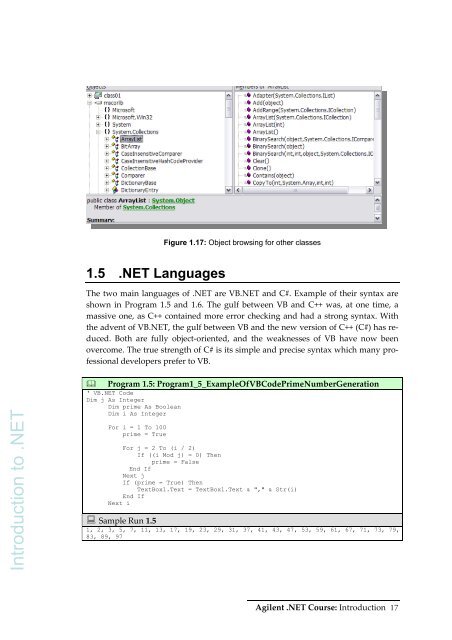Complete set: Intro to C - Bill Buchanan
Complete set: Intro to C - Bill Buchanan
Complete set: Intro to C - Bill Buchanan
You also want an ePaper? Increase the reach of your titles
YUMPU automatically turns print PDFs into web optimized ePapers that Google loves.
Figure 1.17: Object browsing for other classes<br />
1.5 .NET Languages<br />
The two main languages of .NET are VB.NET and C#. Example of their syntax are<br />
shown in Program 1.5 and 1.6. The gulf between VB and C++ was, at one time, a<br />
massive one, as C++ contained more error checking and had a strong syntax. With<br />
the advent of VB.NET, the gulf between VB and the new version of C++ (C#) has reduced.<br />
Both are fully object‐oriented, and the weaknesses of VB have now been<br />
overcome. The true strength of C# is its simple and precise syntax which many professional<br />
developers prefer <strong>to</strong> VB.<br />
duction <strong>to</strong> .NET<br />
<strong>Intro</strong><br />
Program 1.5: Program1_5_ExampleOfVBCodePrimeNumberGeneration<br />
‘ VB.NET Code<br />
Dim j As Integer<br />
Dim prime As Boolean<br />
Dim i As Integer<br />
For i = 1 To 100<br />
prime = True<br />
For j = 2 To (i / 2)<br />
If ((i Mod j) = 0) Then<br />
prime = False<br />
End If<br />
Next j<br />
If (prime = True) Then<br />
TextBox1.Text = TextBox1.Text & "," & Str(i)<br />
End If<br />
Next i<br />
Sample Run 1.5<br />
1, 2, 3, 5, 7, 11, 13, 17, 19, 23, 29, 31, 37, 41, 43, 47, 53, 59, 61, 67, 71, 73, 79,<br />
83, 89, 97<br />
Agilent .NET Course: <strong>Intro</strong>duction 17










![Unit 5. Switches and VLANs [PDF]](https://img.yumpu.com/34422504/1/184x260/unit-5-switches-and-vlans-pdf.jpg?quality=85)





